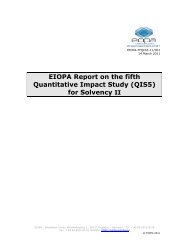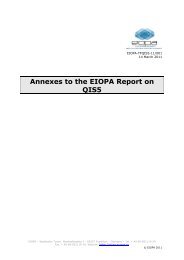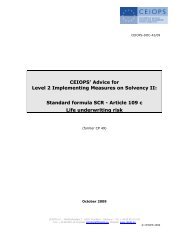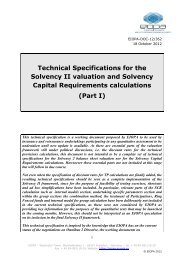CEIOPS Task Force Report on the Liquidity Premium - Eiopa
CEIOPS Task Force Report on the Liquidity Premium - Eiopa
CEIOPS Task Force Report on the Liquidity Premium - Eiopa
Create successful ePaper yourself
Turn your PDF publications into a flip-book with our unique Google optimized e-Paper software.
PART I – LIQUIDITY PREMIUM<br />
C<strong>on</strong>cerning <strong>the</strong> liquidity premium this chapter strives to give a definiti<strong>on</strong> of liquidity of<br />
insurance liabilities, explain <strong>the</strong> relevance of <strong>the</strong> issue, discuss shortcomings and<br />
challenges, examine possible methods of calculati<strong>on</strong> and define <strong>the</strong> possible scope of<br />
a liquidity premium.<br />
In particular answers are provided to <strong>the</strong> following questi<strong>on</strong>s raised in <strong>the</strong> mandate of<br />
<strong>the</strong> <str<strong>on</strong>g>Task</str<strong>on</strong>g> <str<strong>on</strong>g>Force</str<strong>on</strong>g>.<br />
• For which obligati<strong>on</strong>s and/or products <strong>the</strong> inclusi<strong>on</strong> of a liquidity premium<br />
could be allowed for. The characteristics of <strong>the</strong>se obligati<strong>on</strong>s and/or<br />
products will need to be defined (see chapter I-6)<br />
• What <strong>the</strong> implicati<strong>on</strong>s would be for a) policyholders, b) financial stability,<br />
and c) <strong>the</strong> investment policy of <strong>the</strong> undertaking (see chapter I-2)<br />
• Whe<strong>the</strong>r <strong>the</strong> use of a liquidity premium should be limited to business<br />
currently in force, or applied to existing and future business, including a<br />
transiti<strong>on</strong>al period of applicati<strong>on</strong> up<strong>on</strong> <strong>the</strong> introducti<strong>on</strong> of Solvency II,<br />
c<strong>on</strong>sidering implicati<strong>on</strong>s <strong>on</strong> markets. (see chapter I-8)<br />
• How to measure <strong>the</strong> liquidity premium and incorporate it into <strong>the</strong><br />
discount rate in an objective, reliable and c<strong>on</strong>sistent way in order to allow<br />
harm<strong>on</strong>ised implementati<strong>on</strong>. (see chapters I-5 and I-6)<br />
• How often should <strong>the</strong> liquidity premium be revised; (see chapter I-4<br />
principle # 5)<br />
• C<strong>on</strong>sequences of <strong>the</strong> inclusi<strong>on</strong> of <strong>the</strong> liquidity premium <strong>on</strong> <strong>the</strong> overall<br />
solvency positi<strong>on</strong>, in particular <strong>on</strong> <strong>the</strong> SCR standard formula, and whe<strong>the</strong>r<br />
any soluti<strong>on</strong>s proposed may necessitate changes to o<strong>the</strong>r parts of <str<strong>on</strong>g>CEIOPS</str<strong>on</strong>g>’<br />
final advice (see chapter I-7)<br />
I - 1. Definiti<strong>on</strong> of liquidity of an insurance liability<br />
For <strong>the</strong> holder of an asset like a corporate b<strong>on</strong>d, liquidity means <strong>the</strong> ability to sell or<br />
cash in this asset at any time at a price equal to <strong>the</strong> present value of future cash flows<br />
discounted at <strong>the</strong> risk free interest rate, but adjusted for expected credit risk and<br />
credit risk uncertainty (unexpected credit risk).<br />
Illiquidity occurs, for example, where <strong>the</strong> asset is not readily saleable due to<br />
uncertainty about its value or due to <strong>the</strong> lack of a market in which it is regularly<br />
traded.<br />
Where assets are illiquid, investors demand an additi<strong>on</strong>al premium as a reward for <strong>the</strong><br />
risk of incurring additi<strong>on</strong>al transacti<strong>on</strong> costs in case where <strong>the</strong> asset has to be sold.<br />
This additi<strong>on</strong>al premium leads to an increase in <strong>the</strong> implicit yield of <strong>the</strong> instrument,<br />
and hence in <strong>the</strong> spread over and above <strong>the</strong> liquid risk free rate.<br />
However, <strong>the</strong> liquidity premium is <strong>on</strong>ly <strong>on</strong>e comp<strong>on</strong>ent of <strong>the</strong> total spread between<br />
<strong>the</strong> yield of an asset and <strong>the</strong> liquid risk-free rate. This spread also includes a<br />
compensati<strong>on</strong> for o<strong>the</strong>r comp<strong>on</strong>ents such as expected credit risk, credit risk<br />
uncertainty (unexpected credit risk) and management expense risk. Fur<strong>the</strong>rmore, a<br />
4/33<br />
© <str<strong>on</strong>g>CEIOPS</str<strong>on</strong>g> 2010
















